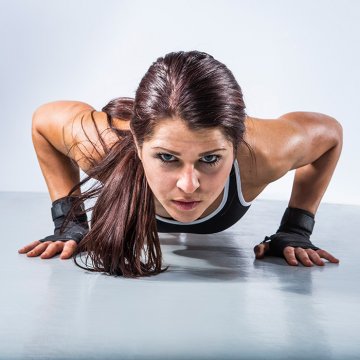 When we are starting to improve our fitness level it sometimes becomes hard to determine where to start. On the flip side, we may work out regularly but feel we have fallen into a rut or have plateaued, and we aren’t getting the results that we are used to. When we find ourselves in these situations, it becomes important to give ourselves a quick Fitness Check.
When we are starting to improve our fitness level it sometimes becomes hard to determine where to start. On the flip side, we may work out regularly but feel we have fallen into a rut or have plateaued, and we aren’t getting the results that we are used to. When we find ourselves in these situations, it becomes important to give ourselves a quick Fitness Check.
Checking 3 simple functional movements and our ability to perform them is a quick and simple way to help us determine what areas of our fitness need help.
Push up
Start in high plank position. Your back and legs should be flat and straight, resting on your toes; your core engaged; your hands level with your chest, and arms fully extended. Pay careful attention and make sure you don’t drop your head forward; it needs to be in line with your back. Slowly drop your chest toward the floor, allowing your chest to gently touch the ground. Pause at the bottom, contracting your core for about 3 seconds, then push yourself back up. Your arms should be straight, without locking your elbows. Breathe in on the way down; breathe out on the way up, through your nose, not your mouth.
Problems:
Inability to bend your elbows and lower your chest all the way down suggests you lack strength in your arms, shoulders, and chest. Inability to maintain your back and legs in a rigid, flat position, thereby allowing either your hips or lower back to sag, suggests a weakness in your core and glutes.
Shoulder Press
To perform a proper dumbbell overhead press, stand with feet shoulder width apart, holding one dumbbell in each hand of a suitable weight. Avoid using weights that are excessively heavy. You want to be able to do 8 to 12 repetitions for this exercise. Keeping your wrists turned inward, lift the weights to starting position, level with your shoulders. Press the weights above your head while turning your palms forward and fully extending your arms. Slowly reverse the movement to complete 1 rep.
Problems:
The inability to extend your arms straight upoverhead suggests a lack of range of motion in your shoulder girdle and weakness in your back muscles. If you find you have to arch your back to raise the weights, you probably have weak core muscles, resulting in a lack of stability, or that your hip flexors are too tight, thereby preventing the proper alignment of your hips and knees.
Squat
Stand with your feet just over shoulder width apart. Keep your back in a neutral position, and keep your knees centered over your feet. Slowly bend your knees, hips and ankles, lowering until you reach at least a 90-degree angle. Make sure your hips are kept in line over your knees, and your knees over your ankles. Return to starting position. Breathe in as you lower, breathe out as you return to starting position.
Problems
The inability to bend your knees and ankles will result in a movement in which you end up raising up on your toes. This suggests tightness in your hip extensors and/or hamstrings, and you’d be wise to start working on improving your hip flexibility. If your knees buckle inward upon lowering or raising yourself up, your hamstrings and glutes are the areas of weakness.
These three movements are not the only functional movements that we can exam to determine our fitness level. Lunges, high steps, planks and many others can also help determine imbalance and help take your health to the next level. We specialize in helping to examine these movements, identify the problems and putting together a plan to improve your motion and strength. If you you would like help improving your health and fitness, please don’t hesitate to give us a call.
